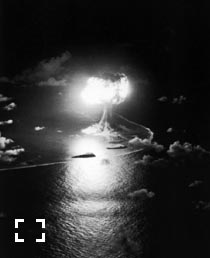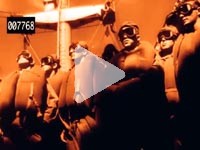 |
|
Operation Sandstone - 1948

Yoke - 30/04/1948
|
Sandstone was the second testing series the United States conducted. Improvements for the implosion bomb had been under development at Los Alamos even before Trinity, but had been put on hold. With Cold War tensions increasing, a need was felt to bring these improvements to the U.S. stockpile. President Truman gave the green light for Sandstone on June 27, 1947. Following the two shot Crossroads operation, Sandstone was an AEC scientific test series. While Crossroads was a weapons effects test on naval ships, Sandstone’s goal was to test experimental designs. Joint Task Force 7 (JTF 7) conducted the test operations. JTF 7 was a joint military and civilian organization, over 10,000 personnel participated
in Sandstone.
Sandstone tested new versions of the existing implosion design weapons developed at Los Alamos during the Manhattan project, and tested during Trinity and Operation Crossroads. Sandstone was the first series that tested implosion systems without plutonium cores. Other experimental principles tested were varying tamper thickness, varying the amount of fissile material in the core. The Sandstone devices used the older Mk-3 implosion system, but proof-tested components that would be used in the Mk-4 bomb.
The original Fat Man pit design used a Christy solid plutonium core, surrounded by a close fitting natural uranium tamper. The Sandstone devices replaced the contiguous tamper-core approach with a "levitated core" in which the core was suspended within a larger hollow space within the tamper so that a gap existed between them. The collision between the tamper and core creates a more efficient compression of the core, due to acceleration of the shockwave across the gap, and reduced Rayleigh-Taylor instability.
These devices also abandoned the use of a pure plutonium core, since oralloy (uranium hihgly enriched in U-235) production had exceeded plutonium production by a factor of over 3-to-1. The first test, X-Ray, used a composite oralloy-plutonium core. Both Yoke and Zebra used an all oralloy core. The pits (tamper plus core) for all three devices weighed about the same.
Previously, the Urchin initiators containing 50 curies of Po-210 had been used, theoretical guidelines suggested as little as 12 curies could be used, but this had never been tested. Given the very short 138 day half life of Po-210, this was an important issue in maintaining a ready stockpile.
Following Sandstone, the X-ray and Zebra core designs were immediately introduced into the U.S. stockpile. This lead to a 75% increase in the U.S. nuclear stockpile at that time. The United States had only 13 weapons stockpiled at the time Sandstone was conducted.
Test Preperation
Enewetak Atoll was selected as a test site on October 11, 1947. Several other Marshall Islands were inspected as possible test sites. Enewetak was chosen because it was large enough to sustain three shots. Also, trade winds would carry fall-out west over open ocean. Also trade wind orientation in respect to Enewetak Island made it possible to construct an air field.

Zebra - 14/05/1948
|
140 people lived on Enewetak when it was chosen as a test site. They were moved to Ujelang Atoll, which had been uninhabited since the last nineteenth century when a typhoon swept over the atoll. The U.S. Navy constructed cisterns, water catchments, latrines, tent frames, and other buildings on Ujelang in November 1947. Enewetak was official closed off on December 2, 1947. By December 20th, all natives of the atoll were moved.
Test operations began a week before each test. On the day before the test, attendance calls, last minute checks, and evacuation of islands was commenced. Three different attendance calls were taken before each shot, at 0600, 1330, and 1800. Only a small group of personnel remained on the atoll during the test, the rest were moved to ships.
Cloud Sampling was done by un-manned B-17 drones. A manned B-17 mother plane controlled each of the drones. After cloud penetration, the drones were landed on Enewetak where the radiological hot filters were removed and sent to Los Alamos. All three shots were conducted at pre-dawn hours. This allowed for recording of visible light emission for study of gamma radiation output as well as enough visible light to pilot the drone B-17 sampling aircraft.
All three Sandstone shots were detonated from 60 meter towers. Prevailing winds at Enewetak tended to spread radioactive fallout in a northerly direction, thus, the succession of the three shots ran north to south. This succession would hopefully minimize the number of personnel exposed to radioactive fallout following each shot.
Outcome
On May 19, the island of Runit was closed off to all personnel. No efforts were been made to fill any of the three craters.
The successful testing of the new cores in the Sandstone tests had a profound effect. Practically every component of the old weapons was rendered obsolete. Even before the third test had been carried out, production of the old cores was ceased, and orders issued that all efforts were to be concentrated on the Mark 4 nuclear bomb, which become the first mass-produced nuclear weapon.
The more efficient use of fissionable material would increase the nuclear stockpile from 56 bombs in June 1948 to 169 in June 1949. The Mark III bombs were withdrawn from service in 1950. At the same time, new production plants were coming online and by May 1951, plutonium production was twelve times that of 1947, while uranium-235 production had increased eight-fold. The Chief of the Armed Forces Special Weapons Project, Major General Kenneth D. Nichols, saw clearly that the era of scarcity was over. He now "recommended that we should be thinking in terms of thousands of weapons rather than hundreds.

| - DNA 6033F - Defense Nuclear Agency report - Sandstone
|
|
|
|
 |







